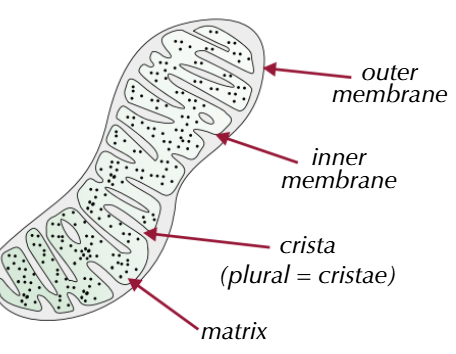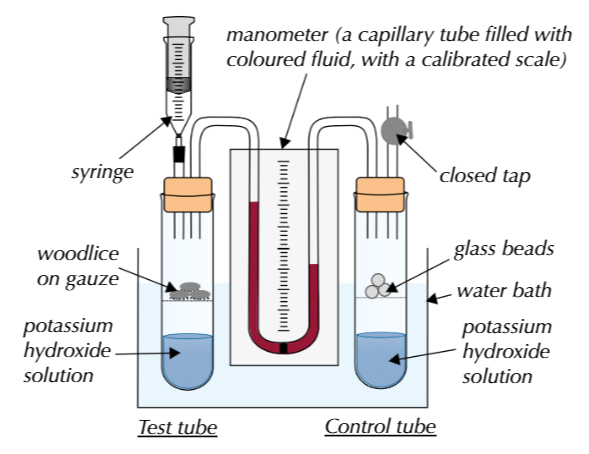3.5 Energy transfers in and between organisms
1/39
There's no tags or description
Looks like no tags are added yet.
Name | Mastery | Learn | Test | Matching | Spaced |
|---|
No study sessions yet.
40 Terms
What are the 3 types of phosphorylation? (forming ATP from the addition of a phosphate group to ADP)
Photophosphorylation- takes place in chlorophyll-containing plant cells during photosynthesis
Oxidative phosphorylation- occurs in the mitochondria of plant and animal cells during the process of electron transport
Substrate-level phosphorylation- occurs in plant and animal cells when phosphate groups are transferred from donor molecules to ADP to make ATP
What are the word and chemical equations for photosynthesis?
carbon dioxide + water → glucose + oxygen
6CO2 + 6H2O → C6H12O6 + 6O2
(‘light’ above arrows)
What are components of the chloroplast?
Thylakoid- contains chlorophyll
Stroma- fluid-filled space that is the site of the light-independent reaction and contains starch grains (immediate energy store for products of photosynthesis)
Thylakoid membrane- site of light-dependent reaction
Granum- stack of thylakoids (increased surface area)
Where does the light-dependent reaction occur?
Thylakoid
Describe the light-dependent reaction
Photoionisation: Photosystem II/ chlorophyll absorbs light so electrons are raised to a higher energy level. Some of the energy from electrons released during photoionisation is conserved in the production of ATP and reduced NADP
Chemiosmotic theory: Electrons are transferred along electron carriers down the electron transfer chain. Protons are transported into the thylakoid to form a proton gradient. They then move down their concentration gradient into the stroma via ATP synthase embedded in the chloroplast membrane. ATP synthase catalyses the production of ATP from ADP and Pi
Electrons are passed to photosystem I and photoionisation occurs again. Electrons are transferred along another set of carriers then are used to reduce NADP which synthesises NADPH
Photolysis of water produces protons, electrons and oxygen. Electrons replace those lost by chlorophyll in photoionisation
Where does the light-independent reaction occur?
Stroma
Describe the light-independent reaction
Fixation of carbon dioxide: CO2 reacts with ribulose bisphosphate (RuBP) to form two molecules of glycerate 3-phosphate (GP). This reaction is catalysed by the enzyme rubisco
ATP and reduced NADP from the light-dependent reaction are used to reduce GP to triose phosphate (TP). Hydrolysis of ATP provides the additional energy
Some of the triose phosphate is used to regenerate RuBP in the Calvin cycle (also uses ATP)
Some of the triose phosphate is converted to useful organic substances eg hexose sugars such as glucose
Explain the factors which affect the rate of photosynthesis
Light intensity- increasing light intensity increases the rate of photosynthesis until it is no longer the limiting factor
Carbon dioxide concentration- increasing CO2 concentration increases the rate of photosynthesis until it is no longer the limiting factor
Temperature- increasing temperature increases the rate of photosynthesis until a point where enzymes eg rubisco denature (also increases rate of respiration which uses glucose therefore net growth of plant is reduced. Oxygen is a competitive inhibitor for rubisco)
*not humidity or water availability as the plant would be dead before one of those became a limiting factor
How can the light compensation point be useful to a commercial plant grower?
If temperature if increased but light intensity is less than or equal to the light compensation point, the plant will respire more than photosynthesise so it will have to use stored glucose and could die over time
How can the effect of environmental variables on the rate of photosynthesis be investigated?
Use aquatic plants, algae or immobilised algal beads
What are the word and chemical equations for aerobic respiration?
Glucose + oxygen → carbon dioxide + water + ATP
C6H12O6 + 6O2 → 6CO2 + 6H2O + ATP
What components make up the mitochondrion?
outer membrane
inner membrane
cristae (large SA)
matrix (contains enzymes involved in oxidative decarboxylation and the Krebs cycle
ATP synthase/ stalked particle
ribosomes (70S)
DNA

What are similarities and differences between mitochondria and chloroplasts?
Similarities
Have outer envelope, own DNA, ribosomes, electron transfer chain
Have membranes which increase surface area
Both fluid-filled
Differences
Matrix in mitochondria vs stroma in chloroplasts
Chloroplasts have chlorophyll but mitochondria don’t
Cristae in mitochondria vs thylakoids in chloroplasts
Chloroplasts have starch granules but mitochondria don’t
Where does glycolysis occur and is it an aerobic or anaerobic process?
In the cytoplasm
Anaerobic
Describe glycolysis
1x glucose phosphorylated to 1x glucose phosphate using 2x ATP (converted to ADP)
1x glucose phosphate produces 2x triose phosphate (TP)
2x triose phosphate oxidised to 2x pyruvate. Net gain of 2x ATP and 1x reduced NAD each
Overall products= 2 ATP, 2 NADH, 2 pyruvate
Where does the link reaction occur?
In the matrix of the mitochondrion
Describe the link reaction
If respiration is aerobic, 2x pyruvate from glycolysis enters the mitochondrial matrix by active transport
Oxidative decarboxylation to 2x acetate (each pyruvate loses 1C in the form of CO2 and is oxidised- reduced NAD produced in the process)
2x acetate combines with 2x coenzyme A in the link reaction to produce 2x acetylcoenzyme A
Overall products= 2x acetyl CoA, 2x CO2, 2x NADH
Where does the Krebs cycle occur?
Matrix of mitochondrion
Describe the Krebs cycle
1 turn of cycle: (1 molecule of glucose= 2 turns)
Acetylcoenzyme A reacts with a four-carbon molecule, releasing coenzyme A and producing a six-carbon molecule that enters the Krebs cycle
6C molecule undergoes oxidative decarboxylation. NAD reduced to
NADH
5C molecule undergoes oxidative decarboxylation. NAD reduced to NADH and ATP generated by substrate-level phosphorylation (Pi added to ADP)
4C molecule converted to acceptor molecule. NAD reduced to NADH and FAD reduced to FADH2- both reduced coenzymes
Overall products (per 1 molecule of glucose)= 4x CO2, 6x NADH, 2x ATP, 2x FADH2
How can methylene blue be used to investigate coenzymes in respiration?
Methylene blue is a redox indicator- it can accept hydrogen atoms and become reduced which turns it colourless.
A test tube with yeast, glucose and methylene blue turns colourless because the indicator accepts hydrogen atoms from the respiring yeast (using the glucose to respire) and becomes reduced.
A test tube with distilled water, glucose and methylene blue stays blue because there is no yeast to accept hydrogen atoms from, therefore the indicator is not reduced. *this test tube is a control to show that the yeast is having an effect, not glucose on its own
A test tube with yeast, distilled water and methylene blue turns pale blue because there is yeast which can respire other respiratory substrates eg amino acids and lipids, causing some indicator to be reduced, however there is no glucose for the yeast to use to continue respiring.
Where does oxidative phosphorylation occur?
Cristae of mitochondria
Describe oxidative phosphorylation
NADH and FADH2 from the first 3 stages release H atoms which split into protons and electrons
Electrons are transferred down the electron transfer chain and lose energy at each level
Energy released is used to pump protons into intermembrane space
Chemiosmotic theory- protons diffuse down electrochemical gradient through ATP synthase which forms ATP from ADP and Pi (3 per NADH and 2 per FADH2)
Oxygen (final electron acceptor) combines with protons to form water
What are other respiratory substrates?
lipids (triglycerides) are hydrolysed into glycerol and fatty acids. Glycerol is phosphorylated and converted to triose phosphate in glycolysis and fatty acids are broken down to 2-carbon fragments then converted to acetyl CoA which enters the Krebs cycle
amino acids are deaminated. 3-carbon compounds are converted to triose phosphate in glycolysis and 4- or 5-carbon compounds are converted to intermediates in the Krebs cycle
What happens if respiration is only anaerobic?
plants and microorganisms eg yeast: pyruvate + NADH → ethanol + CO2 + NAD
animals: pyruvate + NADH → lactate + NAD
The oxidised NAD produced in these ways can be used in further glycolysis
What is respiratory quotient (RQ)?
Volume of CO2 evolved/ volume of O2 absorbed
How does RQ vary for different respiratory substrates?
carbohydrates= 1
fats= 0.7 (contain less oxygen than carbohydrates so require more oxygen for oxidation)
organic acids= >1 (contain more oxygen than carbohydrates so require less oxygen for their oxidation)
How is RQ determined?
Using a respirometer
As respiration occurs, the volume of the air in the test tube containing woodlice will decrease due to oxygen consumed. CO2 produced is absorbed by potassium hydroxide. Pressure in the test tube will decrease and cause the coloured fluid in the capillary tube to move towards it.

What are the 3 groups of organisms depending on how they gain their energy and nutrients?
producers
consumers
decomposers (saprobionts)
What is a producer?
Photosynthetic organism that manufactures organic substances using light energy, water and carbon dioxide
What is the equation for photosynthesis?
6CO2 + 6H2O → C6H12O6 + 6O2
What is chemosynthesis?
Some prokaryotes use the heat from hydrothermal vents instead of sunlight and oxidise inorganic molecules eg hydrogen sulphide, using the electrons to synthesise glucose
What is an autotroph?
An organism that produces complex organic compounds such as carbohydrates, fats and proteins from simple substances present in its surroundings
What is a consumer? (all animals, fungi and most bacteria)
An organism that cannot manufacture its own food and instead obtains its food and energy by taking in organic substances, usually plant or animal matter
What types of organisms are decomposers/saprobionts?
Bacteria and fungi
How do decomposers gain their energy from their food?
They break down the complex organic molecules in dead organic matter into simple minerals, some of which are released back into the environment
What are examples of detritivores and how are they different from decomposers?
Detritivores consume detritus, digest it internally and release nutrients while decomposers break down dead organic matter extracellularly
What does a food chain show?
The direction of energy transfer between organisms in an ecosystem
arrow represent flow of energy
each stage is called a trophic (feeding) level
Eg autotroph→primary consumer/heterotroph/prey→secondary consumer/predator→tertiary consumer→quaternary consumer
What is biomass? What are its units usually?
The total mass of living material in a specific area at a given point in time
Area= g m-2
Volume= g m-3
Why is fresh mass not usually used as a measure of biomass?
Varying amounts of water in the living material
What is dry biomass and what are the disadvantages?
Water is extracted
organisms must be killed
only done on a small sample so may not be representative